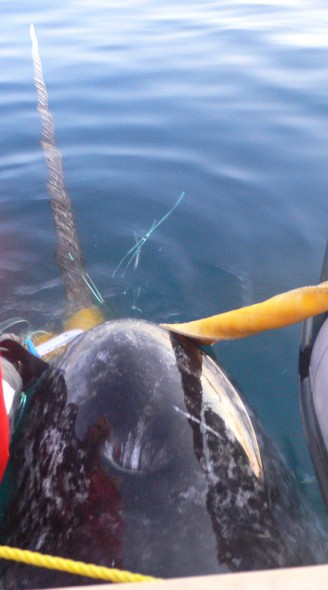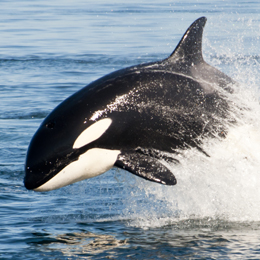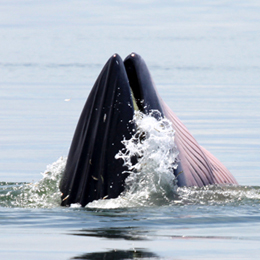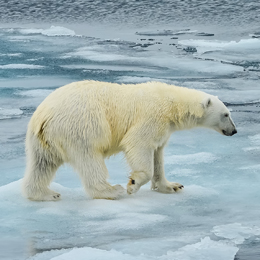Physical Description
The size of an adult Narwhal varies from 4 – 4,8 m (13 – 15 ft) in terms of its range length. A particular characteristic observed in Narwhal whales is that the male is slightly larger than its female counterpart. This peculiarity is observed due to the presence of a long helical tusk, the elongated upper left canine that is found particularly in the male species. Owing to the life-long growth of the canine tooth, male narwhals generally sport an average length of 13 – 14 ft while a female narwhal is 11 – 12 ft in size. The average weight of an adult Narwhal is around 900 – 1600 kg (1985 – 3530 lbs). Narwhals are medium-sized whales that are found primarily in the Arctic waters with an average life expectancy of about 40 years.
Habitat
Narwhals are found in the northern hemisphere throughout the Polar region; a species that favors a specific habitat and occupies a restricted geographical range. They dominate deep waters and can rarely be seen far from loose packs of ice. This species is migratory in nature and follows a particular course depending upon the advance and retreat of the ice. During the summer season Narwhals tend to migrate towards the coasts in groups of 10 to 100 in search of fjords and deep inlets that are known for providing suitable grounds for breeding, birthing and calving.
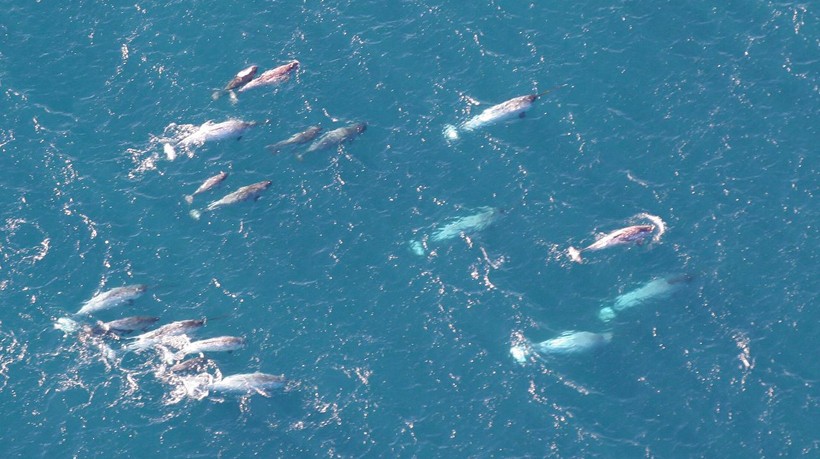
Herd of narwhals swimming, Greenland
?
Image credits: Dr. Kristin Laidre/Public domain
In winters, after the formation of ice on the surface, Narwhals take shelter offshore in the deep waters of the sea, under thickly packed ice that surrounds geologically formed narrow fissures at the surface. Finally, when spring arrives, the fissures open up into channels leading the route of Narwhals back to the coastal bays. If the ice cover is low in deeper water bodies, the species generally moves towards a smaller water body that consists of steep sides and a deep expanse. Unlike the Beluga Whale that prefers shallow estuaries, Narwhals prefer a deep oceanic habitat.
Geographical Distribution
Narwhals can be particularly found in the eastern Arctic waters of Canada and Central Russia. There have been rare sightings in the waters surrounding Siberia, Alaska and West Canada. Though, Narwhals are predominantly found in the Arctic region all year round, they have also been seen swimming in pods near the eastern Mediterranean Sea. Rarely found far from loosely packed ice, large concentrations of Narwhals are often seen along the waters of the Davis Strait, around the Baffin Bay and off the East Coast of Greenland. The northern part of the Hudson Bay, Hudson Strait, inlets of Northern Canada and western Greenland also maintain a large population of Narwhals. During migratory season, the species can be found along the Russian coast of Svalbard, Franz Joseph and Severnaya.
Diet
Narwhals are touted as carnivores with a specific diet that typically includes the Greenland halibut and the Arctic polar cod. Scientists have inferred from their research that the stomach contents of an adult Narwhal include 51% of Arctic cod and 37% of Greenland halibut. Since Narwhals are capable of diving more than 500 m below sea level their most preferred catch is the Arctic cod.
Besides this Narwhals also have a peculiar craving for cuttlefish, shrimp and Armhook squid, all of which are found swimming within the deep ocean. Research also states that adult Narwhals particularly hunt down Wolfish and Capelin while young calves prefer feasting on Skate eggs.
Anatomy
Narwhals exhibit bilateral symmetry and sexual dimorphism where males have a larger body length as compared to females because of a distinguishing anatomical feature – the male tusk. This characteristic long tusk is basically an extended canine tooth that measures approximately to around 240 centimeters. The length of the tusk may vary depending upon the maturity of a male narwhal. On the contrary, the right canine tooth that measures around 30 centimeters remains embedded within the skull. Head of a Narwhal is relatively small with a blunt snout that appears short and rounded.

Narwhal skull with double tusks, a very rare trait in narwhals. Zoologisches Museum, Hamburg
?
Image credits: soebe/CC BY-SA, original image.
The pointed end of the tusk sports a polished appearance while the rest consists of a reddish or greenish coloring. Tusks in females are very rare and occur in one out of 500 females. However, a female can have either a single tusk or a double tusk. In the case of a double tusk, both tusks are twisted complexly against each other often resembling a spiral. Narwhals also exhibit a mottled pigmentation or white blotches on their pale bluish skin. They are also known to be endothermic creatures i.e. animals that are capable of generating internal heat to regulate their body temperature that is independent of the atmospheric temperature.
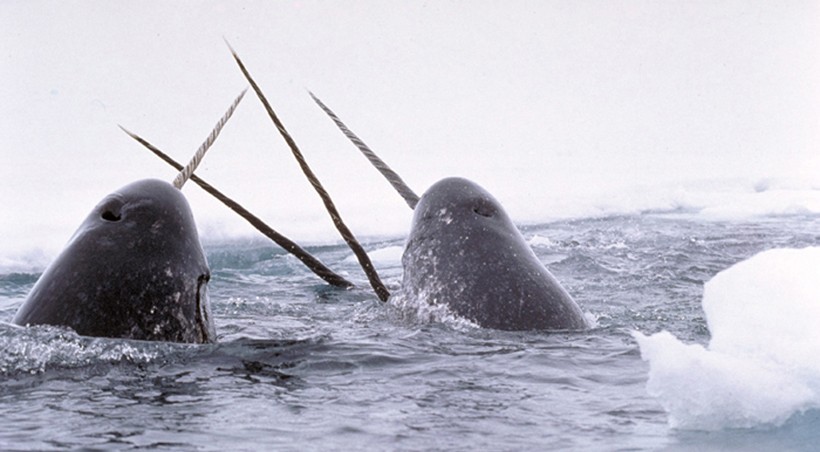
Narwhals exhibit a mottled pigmentation or white blotches on their pale bluish skin.
?
Image credits: Glenn Williams/Public domain
Narwhals do not possess a dorsal fin, however, there seems to be an irregular ridge of about 5 centimeters in height that extends along the posterior half of its back. While the pectoral fins are 30-40 centimeter in length, the tail flukes of a Narwhal are normally 100-120 centimeter long. As opposed to other cetaceans, Narwhals have convex posterior margins around their tail flukes rather than concave or straight. Female Narwhals have tail flukes with front edges that are swept back. When compared to its opposite sex, a male Narwhal sports tail flukes that appear slightly concave in shape.
Prey
Narwhals have improper dentition with only two teeth, both of which are present in the upper jaw. In females, the teeth aren’t functional since they’re embedded deep within the bone. In males, while the right tooth is found to be embedded, the left tooth erupts out through the upper lip that grows into an elongated tusk. Narwhals, therefore, hunt by getting close to their prey and sucking it with a strong force. This directly pushes the prey into its mouth, a characteristic that is quite similar to beaked whales who also hunt their prey using suction force.
Narwhals are close range hunters that travel in the Arctic waters. On reaching close enough to a shoal, they emit a jet stream (water) to dislodge and blindside their prey. Once their prey is caught in the torrent of the jet-stream, Narwhals use an immense amount of suction force to engulf their prey. Using a highly flexible neck and their elongated tusk they can easily scan the swimming grounds closely. The tusk is an innervated sensory organ that consists of a million micro-nerve endings that collects the water-borne particles and sends instant stimuli to the brain.
Forehead melons in a Narwhal are also sensory organs which enable it to sense the oscillation of waves within the ocean. This allows them to easily discern the presence of other aquatic life in the surrounding and thereby capture mobile prey like fish, crustaceans or mollusks.
Predator
Narwhals use their elongated tusk to ward off predators in the sea that can be a formidable weapon if several of their kind gather to aid a victimized Narwhal. They are normally slow moving creatures but can be remarkably quick due to the streamlined shape of the tusk. Polar bears prey upon young Narwhals by attempting to swipe at the breathing holes. Killer whales form groups in order to hunt a Narwhal down that has gone astray from its pack. Small or weak Narwhals are also preyed upon by Greenland sharks and Walruses. During an escape, Narwhals tend to submerge under the ice to get away from their predators. But the biggest threat to the species is Humans who have been known for killing the species illegally for its tusk, skin and meat.
Reproductive Cycle
Narwhals are seasonal breeders that mate during the summer months from March to May. Post-mating, calving occurs in the month of July and August the following year. The gestation period of a female Narwhal can be around 15.3 months (approx) where the fertilization is viviparous. The period of lactation remains unknown. Yet is said to be on par with a White whale which is approximately 20 months.
Narwhals copulate in shallow waters, in a vertical position from belly to belly which takes place after a male Narwhal finds its suitable mate. Infant Narwhals are usually implanted in the left uterine horn of a female Narwhal. As a result of this, only a single calf is born normally, although the birth of twin calves has also been recorded. After birth, newborn calves are nursed for about four months by the mother
Baby Narwhals are born with the tail first, 25 mm blubber and an even-colored skin tone. Each baby Narwhal is born brown with the absence of any spots or freckles on its body. It measures 1.5 – 1.7 m on an average and weights around 80 kg at birth. Males attain physical maturity after 11 years when they weight about 1600 kg with a body length of 4.7 meters. Female Narwhals mature physically at the age of five when they attain a size of 4 m in length and weight 900 kg.
Hybrids
Narwhals very rarely interbreed with any species of the Beluga whale to produce an offspring that features prominent characteristics of both a Narwhal and a Beluga whale. Marine biologists most of the times refer to them as an ‘anomalous species’ of a Narwhal-Beluga hybrid.
Behavior
Like many other whales, Narwhals love to travel in groups. A group of Narwhals mostly consists of 5-10 members. Narwhals seem to prefer cold atmospheric conditions and, therefore, inhabit ice cold regions of the Arctic Ocean as opposed to humid seas of the Antarctic. Apart from loose blocks of ice, Narwhals dwell in seas that are as deep as 400-800 meters at a stretch. They are pack oriented species that migrate towards shallow waters during the mating season.
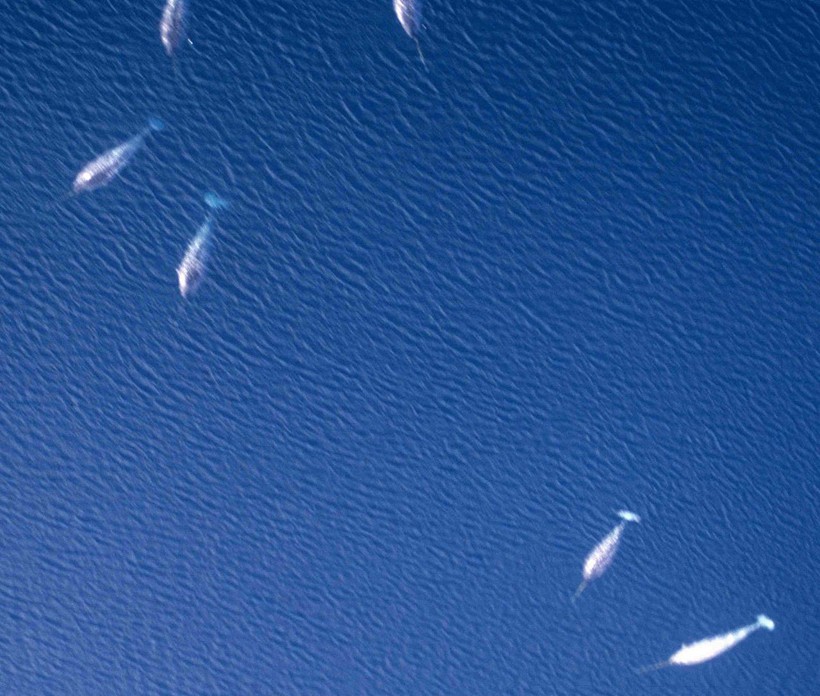
Narwhal group at the Creswell Bay (Somerset Island)
?
Image credits: Ansgar Walk/CC BY-SA, original image
They congregate in pods which contain a specific age group of Narwhals. A group with female Narwhals with their young is termed as the ‘nursery’. Besides nurseries, ‘bulls’, a group of juveniles or adult males and mixed groups are also commonly part of the herd. During the summer season, many migration groups come together and increase the population strength to around 500 to 1000 individuals. This helps to ward off predators like Killer whales and Greenland sharks that target the young.
A unique behavioral pattern observed by Narwhals is the rubbing of its tusk with one another within a group of bulls that is known as ‘tusking’, a characteristic that is deemed to prove social dominance. Apart from displaying supremacy, tusks also impart information regarding the living biota, environment and predatory warning. Narwhals mainly communicate using sounds to navigate, mate and hunt. Some of these sounds are ‘clicks’, ’whistles’ and ‘knocks’. These sounds are created through the air that exists between the chambers found near the blow hole.
‘Clicks’ are produced for locating prey and obstacles at a short distance by a method popularly used by all whales - echo reflection. These sounds are then focused into the animal’s melon that is regulated by musculature. It has been estimated that narwhals also produce ‘bangs’ in order to incapacitate the prey which makes hunting an easier affair. ‘Whistles’ are a sound rarely produced by Narwhals unless they’re vying for a mate. Other sounds produced by Narwhals include trumpeting and squeaking.
Threats
Study of Narwhal ecosystems concludes that the average life expectancy of a Narwhal is as long as 40 years in the wild. However if bred in captivity, they can survive longer. Some Narwhals, however, die at a younger stage for several reasons like suffocation, starvation or human instilled threats. A young calf can often suffocate when the sea ice freezes over. Narwhals are most vulnerable to climatic change and altering sea levels. A rise in global warming and pollution by humans has upset the density, pH and chemical components of seawater. Due to the consistent melting of icecaps in the Baffin Bay larger blocks of ice compress young Narwhals easily suffocating them each season. Seismic surveys related to oil exploration upset migratory pattern of the species by disrupting sound waves within the ocean.
The population of Narwhals has considerably reduced to 75,000 making it a nearly extinct species of the Arctic ecosystem. Human practices like illegal fishing and trawling in waters of Northern Canada and Greenland are major causes for this population decline. The demand of a Narwhal’s ivory tusk has greatly increased and its hunting is practiced legally in few countries. In 2002, a sudden rise in Narwhal catches took place in Siorapaluk that made the species vulnerable to illegal hunting. With the food chain disrupted, there is a limited catch for the species that causes them to migrate away from their native grounds in search of prey into human populated waters.
Conservation Status & Ecological Significance
According to the IUCN, Narwhals are listed as ‘Near Threatened’ with a population that is already on a decline. Altering sea coverage, human exploitation and loss of foraging grounds have visibly reduced their population to a mere 75,000 although some reports indicate the population being only 45,000. They have already been listed in Appendix II of the CITES and have been placed for consideration on the US Federal List. The International Whaling Commission is responsible for regulating whaling and checking the vast number of problems whale species are facing. Placement of satellite radio transmitters on Narwhals helps to track their progress in the sea and learn more regarding their life cycle.
In the aquatic ecosystem, Narwhals play a significant role in a practice known as commensalism. In this commensalism situation, Narwhals harbor many microbes and sea animals on their skin like whale lice, nematodes, trematodes, Acanthocephalans etc.
Funfacts
- Narwhals show seasonal migration trends, however after this migration they often return to their previous place of ice-free grounds.
- Narwhals are said to conceive periodically over a gap of three years.
- During deep dives, the tusk of a Narwhal may be helpful in digging up food from bottom sediments.
- The largest entrapment of Narwhals took place in 1915 in West Greenland where over 1000 of this species remained trapped under frozen ice.
- The Inuit community prizes Narwhals for its skin which is known as ‘Mattak’ or ‘Muktuk’ that is a known delicacy because of the thin layer of fat.
- Narwhals can dive up to 1500 meters deep, a dive that takes about 10 – 25 minutes.
- The shape of a Narwhal’s tail flukes is adapted to particularly reduces drag.
